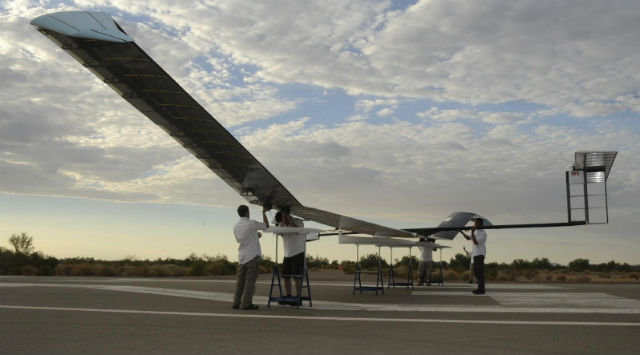Airbus Defence & Space is planning to offer a high-altitude unmanned air vehicle-based surveillance capability for disaster relief, using a variety of systems that it is in the process of finalising.
Speaking to media in London on 25 November, Steve Whitby, strategic business manager, said the company’s Zephyr high altitude pseudo satellite (HAPS) could receive data feeds from aircraft carrying the company’s Mobile IP Node communications relay payload, which could then feed back to the Deployable Communication and Information System (DCIS) that it has developed for NATO.
The announcement comes at a time when the company is waiting to deliver three of its NATO Response Force DCIS systems to the Alliance, following a successful trial in March. The system underwent a couple of weeks of testing in Poland – the current signals rotational lead in NATO – and received positive feedback on its performance.
“UAVs and aircraft collect lots of imagery. How do you get that back to whoever needs it?” Whitby asks. “We are definitely predicting that this will easily provide the user with a communications hub, particularly in scenarios such as disaster relief, when there is no infrastructure.”
The combination of systems would provide a low-cost, easily deployable surveillance capability, Whitby says, which would be ideal for disaster relief situations when speed of deployment is essential and infrastructure is likely to be absent.
For this application, the company’s communications relay Mobile IP Node could be integrated onto airborne warning and control system air platforms, as well as other surveillance aircraft. These would feed back to the Zephyr, which could then relay all information to the DCIS.

Airbus Defence & Space
The Zephyr has demonstrated its capability to remain airborne for 35 days and is expected to carry out some 90 days of tests by the end of 2015.
Zephyr 7 – now designated PS001 – was the first HAPS to be registered in the UK, following an 11-day nonstop flight in winter conditions, deployed with an undisclosed payload and controlled via satellite communications for the first time.
The approval test was carried out in controlled airspace under the supervision of the Ministry of Defence, the Military Aviation Authority, the Type Airworthiness Authority (TAA) and the unmanned air vehicle arm of the MoD’s Defence Equipment and Support group.
The Mobile IP Node, meanwhile, is currently at technical readiness level six, with some systems already sold for live trials currently undergoing testing.
The DCIS was contracted for £40 million ($63 million) in 2009 – although the contract now stands at nearer £50 million – and three systems have been developed.
Controlled by NATO’s three signals battalions at any given time, the communications systems will be easily deployed in light of the changing environment in which NATO troops operate, and are scalable to range from facilitating operations for a few operators up to some 500 users, Whitby says.
One of the key requirements for DCIS was that the whole system can be deployed in one Lockheed Martin C-130 Hercules transport, which allows for reduced cost.
Meanwhile, NATO is also looking at deploying the DCIS system via precision parachute drop, and is currently in discussions with NATO regarding the development of a smaller variant. A draft requirements document has been written, but the company is awaiting a final request for proposals.
Source: FlightGlobal.com






















